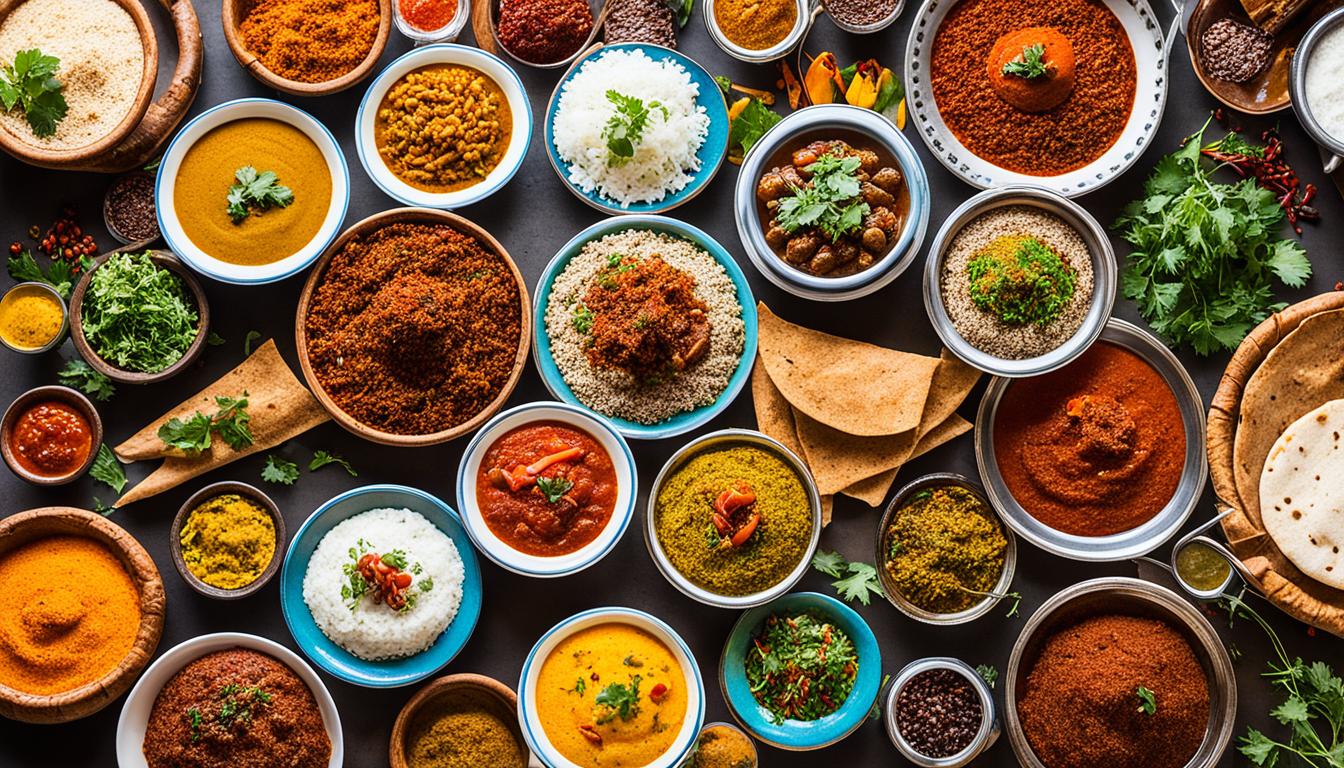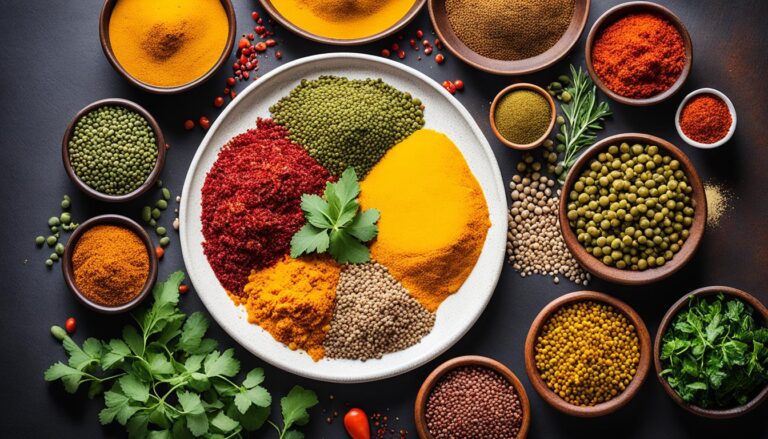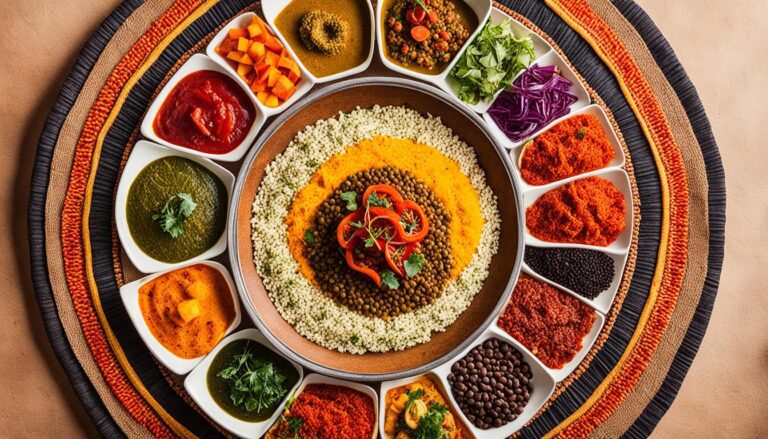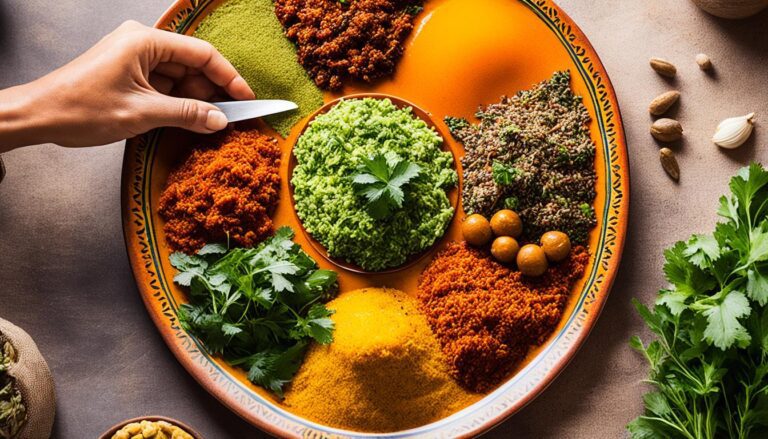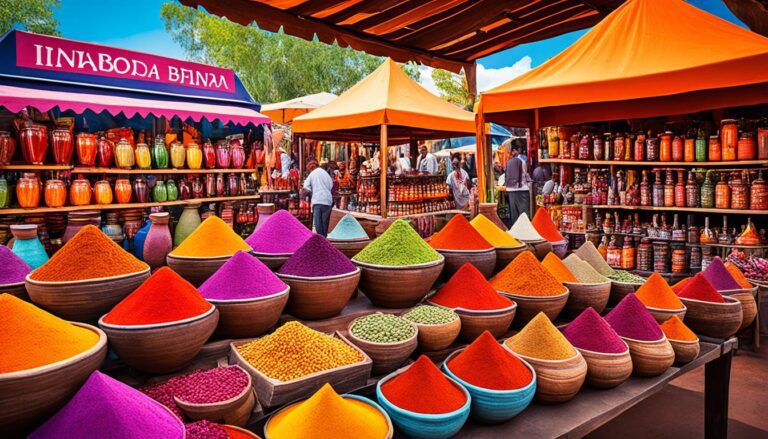What Does Ethiopian Food Taste Like?
Welcome to a flavorful journey through the vibrant world of Ethiopian cuisine. The tantalizing aromas, diverse flavors, and rich traditions of Ethiopian food await us as we explore this unique culinary experience. Have you ever wondered what Ethiopian food tastes like? Prepare to be captivated by a blend of spices, the tang of fermented injera, and the intriguing flavors of various regional specialties.
Key Takeaways:
- Ethiopian food offers a unique and diverse sensory experience.
- Ethiopian cuisine is deeply rooted in cultural and traditional practices.
- Ethiopian spices and seasonings add complexity and depth to the dishes.
- Ethiopian cuisine caters to vegetarians and vegans with flavorful options.
- Each region in Ethiopia contributes distinct flavors and culinary traditions.
Ethiopian Food Culture and Traditions
Before we delve into the tantalizing taste of Ethiopian food, let’s take a moment to explore the rich cultural and traditional aspects that shape this cuisine. Ethiopian food is much more than just a meal; it is a reflection of their history, social customs, and sense of community.
At the heart of Ethiopian cuisine is injera, a staple flatbread that serves as the foundation for many dishes. This unique bread, made from fermented teff flour, has a slightly sour taste and a spongy texture that pairs perfectly with the vibrant flavors of Ethiopian dishes.
Another fascinating aspect of Ethiopian food culture is the tradition of communal eating. Meals are often served on a large platter called a mesob, and it is common for people to gather around and share dishes. This communal style of dining emphasizes the importance of togetherness and connection, creating a sense of unity and celebration.
Ethiopian food is also known for its distinct eating etiquette. Traditionally, food is eaten with the right hand, using torn pieces of injera to scoop up the various dishes. This tactile experience not only adds to the sensory journey of flavors but also reinforces the communal aspect of sharing a meal.
Ethiopian Coffee Ceremony
No discussion of Ethiopian food culture would be complete without mentioning the famous Ethiopian coffee ceremony. Coffee has a deep-rooted significance in Ethiopian culture and is often enjoyed in a ceremonial fashion. The coffee beans are roasted, ground, and brewed in front of guests, creating an aromatic and social experience that is steeped in tradition.
Ethiopian Spices and Seasonings
One of the defining characteristics of Ethiopian food is its bold and aromatic use of spices and seasonings. These flavors add complexity and depth to Ethiopian dishes, creating a truly unique taste.
One popular spice blend in Ethiopian cuisine is berbere, a fiery mixture of spices that includes chili peppers, paprika, fenugreek, and various aromatic herbs. It is the cornerstone of many traditional Ethiopian dishes, providing a rich and spicy flavor profile.
Another essential seasoning in Ethiopian cooking is niter kibbeh, a clarified butter infused with herbs and spices. The process of making niter kibbeh involves simmering butter with a combination of ingredients such as garlic, ginger, cinnamon, and cardamom. This fragrant butter adds a subtle and milder flavor to dishes, complementing the robustness of the berbere spice blend.
Ethiopian cuisine also incorporates other aromatic spices like garlic, ginger, cumin, coriander, and turmeric, which further enhance the overall taste experience. These spices not only contribute to the savory flavors of meat and vegetable dishes but also play a crucial role in preserving and marinating ingredients.
The use of spices and seasonings in Ethiopian cooking is not just about adding heat and flavor; it is a reflection of the country’s history, trade routes, and cultural influences. The versatility and complexity of Ethiopian spices make each bite a delight, transporting you to the vibrant flavors of Ethiopia.
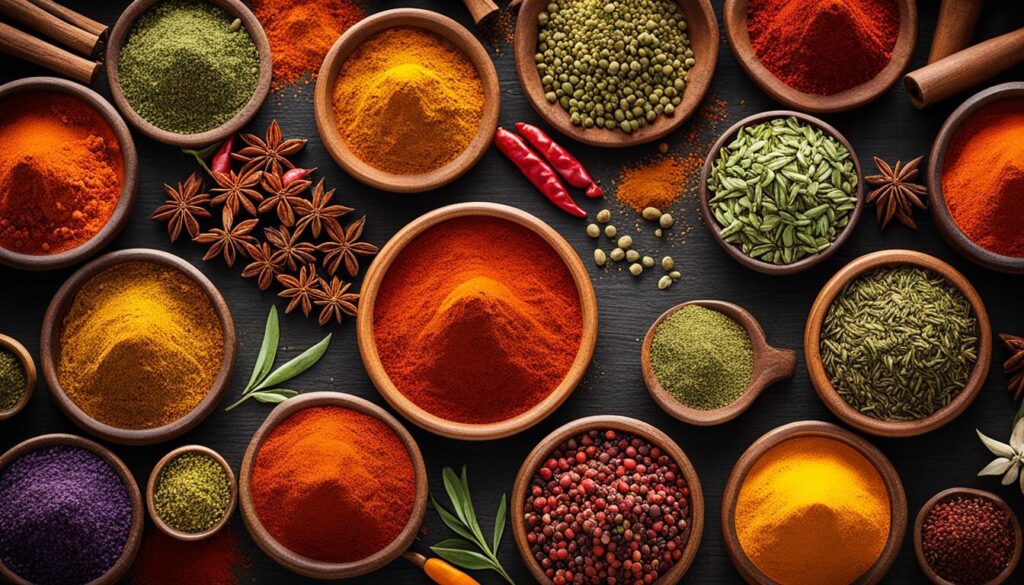
Flavors and Aromas in Ethiopian Cuisine
Ethiopian cuisine is a treasure trove of vibrant flavors and enticing aromas that tantalize the taste buds. Each dish showcases a unique combination of spices and ingredients, resulting in an explosion of taste sensations.
One of the most beloved Ethiopian dishes, doro wat, captures the perfect balance between tanginess and savory goodness. Made with succulent chicken simmered in a rich berbere sauce, it is a delightful exploration of flavors that leaves a lasting impression.
For those seeking a bold and adventurous taste, kitfo is an absolute must-try. This traditional minced raw meat dish is seasoned with spices and mixed with vibrant herbs, resulting in a rich and buttery indulgence that is sure to satisfy even the most discerning palate.
The art of spice is prevalent throughout Ethiopian cuisine, with each region showcasing its own unique spice blends. From the fiery mitmita spice of the Afar people to the aromatic korerima used in the South, these spices add depth and complexity to Ethiopian dishes, elevating them to a whole new level of culinary excellence.
Moreover, Ethiopian cuisine is a perfect fusion of flavors and aromas that come together harmoniously. The combination of herbs like nigella and cardamom, alongside spices such as cinnamon and cumin, creates an enticing aroma that whets the appetite even before the first bite.
Whether you prefer tangy, savory, or spicy flavors, Ethiopian cuisine caters to a wide range of taste preferences. With its diverse array of dishes and tantalizing aromas, every dining experience becomes a culinary adventure that delights the senses and leaves an everlasting impression.
Vegetarian and Vegan Options in Ethiopian Food
Ethiopian cuisine embraces diversity and caters to a range of dietary preferences, making it a haven for vegetarians and vegans. Whether you have chosen this lifestyle for health, environmental, or ethical reasons, Ethiopian food offers a multitude of flavorful and satisfying plant-based options that will leave you craving for more.
One popular vegetarian dish is misir wat, a spicy red lentil stew infused with aromatic spices. This hearty dish is bursting with flavors and pairs perfectly with the staple Ethiopian bread, injera.
For the greens enthusiasts, gomen is a must-try dish. This sauteed collard greens dish features tender greens, sauteed with onions, garlic, and herbs, creating a vibrant and nutritious side dish.
If you’re looking for a protein-packed option, shiro is the way to go. Made from finely ground chickpea flour, this savory stew is simmered with spices, onions, and garlic, resulting in a satisfying and aromatic dish.
Satisfy your tastebuds with these vegetarian and vegan Ethiopian dishes.
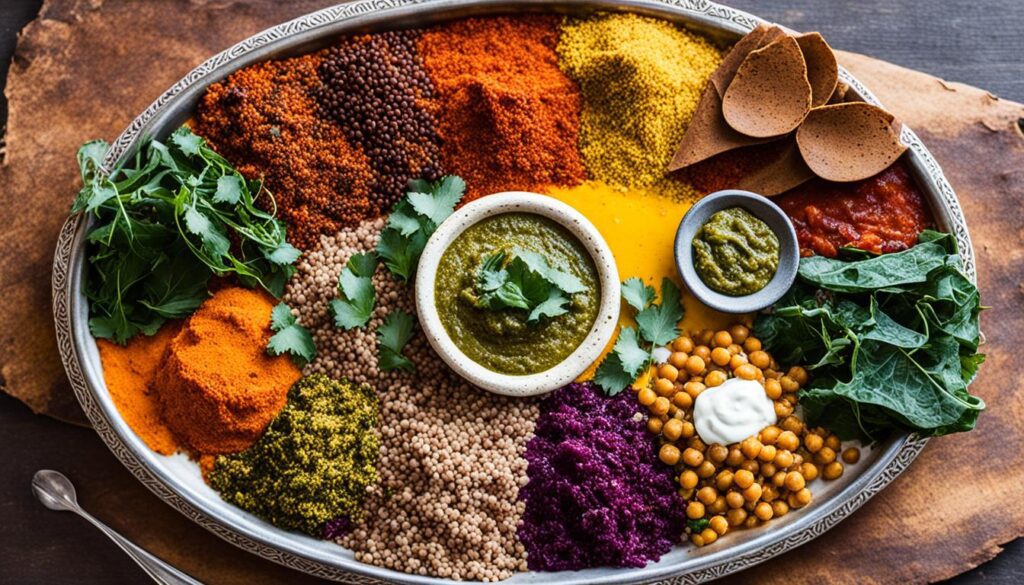
Regional Varieties and Specialties
Ethiopia is a country of incredible diversity, and its culinary landscape reflects this rich tapestry of cultures and regions. Each part of Ethiopia has its own unique flavors and specialties, contributing to the country’s vibrant culinary traditions.
One notable region is the Amhara region, known for its spiced meat dishes that are full of bold flavors. Dishes like doro wat, a spicy chicken stew, and kitfo, a minced raw meat delicacy, showcase the Amhara region’s love for robust and savory flavors.
Another region with distinct culinary traditions is the Gurage region, famous for its spiced butter-infused dishes. The use of niter kibbeh, a clarified butter infused with spices and herbs, adds a rich and aromatic dimension to Gurage cuisine. This region offers a unique and tantalizing flavor profile that sets it apart from other Ethiopian cuisines.
Other regions within Ethiopia, such as Tigray, Oromia, and Southern Nations, Nationalities, and People’s Region (SNNPR), also contribute their own delectable specialties to Ethiopian cuisine. From fiery stews to hearty vegetarian dishes, these regions offer a diverse range of flavors that reflect the local ingredients and cultural influences.
Exploring the regional varieties and specialties of Ethiopian cuisine allows us to truly appreciate the depth and complexity of this incredible culinary heritage.
Ethiopian Food in the United States
Ethiopian cuisine has become increasingly popular worldwide, and the United States is no exception. From coast to coast, you can find a variety of establishments that offer authentic Ethiopian flavors and dishes. Whether you’re in a bustling city or a small town, the vibrant taste of Ethiopia is never too far away.
Traditional Ethiopian restaurants are a haven for food enthusiasts seeking an immersive dining experience. With their warm and inviting ambiance, these establishments allow you to savor the flavors of Ethiopia while also appreciating its rich cultural heritage. From injera, the spongy fermented flatbread, to a wide array of stews and meat dishes, these restaurants strive to bring an authentic taste of Ethiopia to your table.
Food trucks and casual eateries have also stepped up their game, offering on-the-go options for those craving Ethiopian flavors. These mobile kitchens bring the vibrant spices and unique combinations of Ethiopian cuisine to the bustling streets of American cities. From injera wraps to flavorful meat and vegetable dishes, these establishments cater to the demand for quick and convenient yet authentic Ethiopian food.
The reception of Ethiopian food in the United States has been overwhelmingly positive. As people explore the diverse culinary landscape, Ethiopian cuisine stands out with its distinct and bold flavors. Food enthusiasts and adventurous eaters delight in the boldness of Ethiopian spices and the communal style of eating, which encourages sharing and connection.
Evolution to Suit the American Palate
As Ethiopian cuisine gains popularity in the United States, it has also evolved to suit the American palate. Chefs and restaurateurs have adapted traditional recipes while staying true to the essence of Ethiopian flavors, creating a fusion that appeals to a wider audience. From milder versions of spicy dishes to creative innovations, Ethiopian food continues to captivate and satisfy an ever-growing fan base.
As our taste for global flavors continues to expand, Ethiopian cuisine holds a special place in the hearts and palates of Americans. The bold spices, communal dining experience, and rich traditions all contribute to the allure of this culinary journey.
Conclusion
In conclusion, Ethiopian cuisine offers a tantalizing fusion of flavors that will take your taste buds on a remarkable journey. From the bold and aromatic spices to the communal dining experience, Ethiopian food is a celebration of culinary traditions and cultural heritage.
Whether you crave fiery and spicy dishes or prefer milder flavors, Ethiopian cuisine caters to a diverse range of palates. With a variety of vegetarian and vegan options, it is a cuisine that welcomes all dietary preferences without compromising on taste.
We encourage you to explore the diverse tastes of Ethiopia and immerse yourself in the vibrant world of Ethiopian food. Indulge in the rich and buttery flavors of kitfo, savor the tangy doro wat, and experience the unique sensation of injera, the traditional Ethiopian flatbread. Let your senses be captivated by the exquisite blend of spices and the authentic traditions that make Ethiopian cuisine truly special.
Embark on a culinary adventure and discover why Ethiopian food has gained popularity not only in its home country but also around the world. Whether you seek out a traditional Ethiopian restaurant or try your hand at cooking Ethiopian dishes at home, the flavors of Ethiopia are sure to leave a lasting impression and create unforgettable dining experiences.

